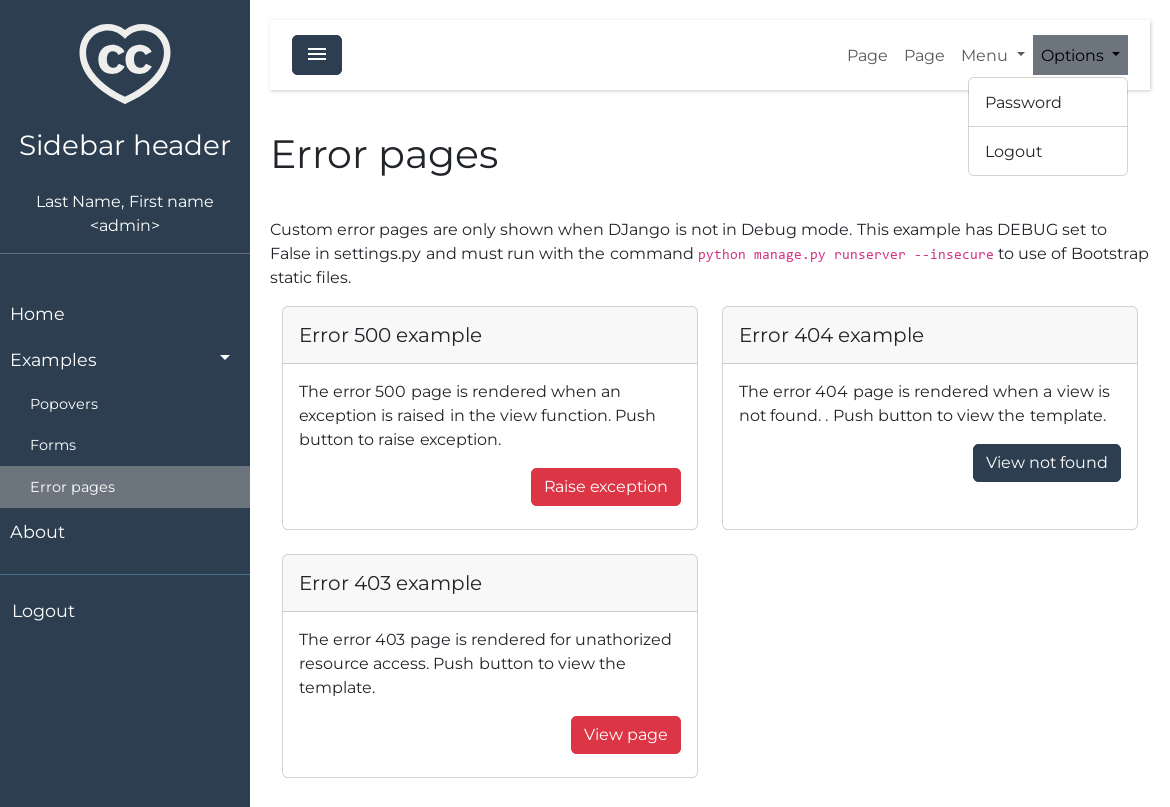Collapsible Sidebar Using Bootstrap is a base template with a bootstrap simple customization in self-hosted mode (non-CDN).
Features:
- Bootstrap 5.3
- Django 4
- Included demo at example folder
- Templates included:
- bootstrap_base.html
- snippets/show_err.html
- snippets/show_messages.html
- Templates overridden:
- registration/login.html
- registration/password_change_form.html
- 403.html
- 404.html
- 500.html
- Bootstrap customization available at bootstrap-theme directory.
- Custom font from google-fonts in local static files.
Bootstrap theme and fonts are customizable using scripts included. See details bellow.
An example is included in the example folder with a Makefile to initialize the project and preview the templates. More details in example/README
The preferred way to install is via pip
pip3 install django-bootstrap-sidebar
but you can install in develop mode cloning this repo but static files are not included in the repo. See Customize bootstrap theme section for details.
After installing your Django instance in settings.py, add bootstrapsidebar
before django.contrib.auth since some auth templates are overridden.
INSTALLED_APPS = [
'bootstrapsidebar'
'django.contrib.auth',
...
]The base template (bootstrap_base.html) includes the following hierarchical
blocks:
- block custom-css
- block head
- block page-wrapper: to override full page, included sidebar.
- block sidebar
- block navbar: to override top navbar
- navbar-links: only to add links in default template navbar.
- block messages: by default this block uses
snippets/show_messages.html - block content
- block footer
- block after-bootstrap-js: used to run extra javascript like to enable Bootstrap Popovers. See below details
The registration/login.html is an example of page using base-template without
sidebar.
Install the package in dev mode is recommended if you want to customize the Bootstrap Theme. First clone this repo and install in dev mode:
pip install -e ./django-bootstrap-sidebar
Bootstrap static files and fonts are not included in the repo. They are
generated/downloaded with the commands of makefile but the node environment
and npm are required.
Bootstrap can be customized at file bootstrap-theme/custom.scss. An easy way
to create a new customization is some online theme builder
like https://bootstrap.build/ and download the custom.scss.
To generate/upgrade static files makefile automates the process, run make:
make
Due performance reasons popovers are not default enabled. One way is to enable popovers everywhere, which requires an extra javascript after the Bootstrap javascript. The last solution is not optimal, but it is a simple way, a detailed instructions are available at Bootstrap Popovers
The block after-bootstrap-js is intended to enable popovers and
the following code snippet from Bootstrap can be used:
{% block after-bootstrap-js %}
<script>
const popoverTriggerList = document.querySelectorAll('[data-bs-toggle="popover"]')
const popoverList = [...popoverTriggerList].map(popoverTriggerEl => new bootstrap.Popover(popoverTriggerEl))
</script>
{% endblock %}A full example is included in the example folder in page
popovers.html
The project is licensed under the Apache 2.0 license.
Developed and maintained by Paulino Ruiz de Clavijo Vázquez pruiz@us.es

